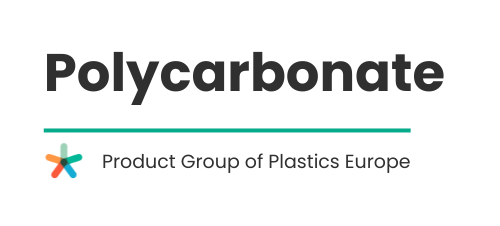Polycarbonate & policy:
Sustainability, electrification, and safety
Governments worldwide are setting ambitious climate and safety goals, driving demand for cleaner energy, advanced materials, and enhanced safety standards.
Polycarbonate plays in to these goals as it holds a critical role in reducing emissions, improving energy efficiency, and ensuring safety across industries.

Reducing carbon emissions & advancing circular economy
With policies focused on carbon neutrality and resource efficiency, polycarbonate supports sustainability:
- Lightweight materials for transportation – Polycarbonate reduces vehicle weight in EVs, aerospace, and automotive glazing, improving efficiency and lowering CO₂ emissions.
- Energy-efficient buildings – Polycarbonate used in glazing, insulation, and LED lighting, helps to reduce energy consumption.
- Renewable energy systems – Polycarbonate is a crucial part in electronic components used for solar panels, wind turbines, and energy storage solutions with durability and impact resistance.
- Recycling & circular economy – advances in mechanical and chemical Polycarbonate recycling contribute to a closed-loop material economy.
Did you know?
Key Role in Sustainability – Polycarbonate is highly recyclable, mechanically and through dissolution. Research is ongoing to develop bio-based alternatives.
Reduction of emissions – Studies show that lightweighting can reduce GHG emissions by approximately 6-8% for every 10% weight reduction in a vehicle.
Lightweight & Transparent – Despite its durability, polycarbonate is half the weight of glass while maintaining excellent optical clarity.
Energy saving in buildings – Building energy usage can be reduced by up to 40% through improved thermal insulation and natural lighting, lowering the carbon footprint.
Extreme Strength & Toughness – Polycarbonate is nearly 250 times stronger than glass, making it highly impact-resistant.

Key for EVs, smart grids, and energy storage
As governments push for electrification and renewable energy, polycarbonate enables high-performance solutions for energy infrastructure:
- EV charging stations & batteries – Polycarbonate provides flame-retardant, impact-resistant casings for improved safety and longevity, as well as dimensional stability in battery cellholders.
- LED & smart lighting – Polycarbonate enhances light transmission, durability, and efficiency in modern lighting systems.
- Smart grids & electrical components – Polycarbonate is a crucial part in electronic components used for solar panels, connectors, and energy storage solutions.
Did you know?
Heat & Flame Resistance – Polycarbonate can withstand temperatures up to 150°C (300°F) and is naturally flame-retardant.
Aerospace & Automotive Use – It is widely used in aircraft windows, car headlights, and sunroofs due to its impact resistance and lightweight properties.
EV loading stations – Millions are already installed, and growing – key components of them are made with polycarbonate due to its weather resistance and flame retardancy.

Trusted for safety requirements in automotive, medical, and industrial applications
Strict safety and fire regulations are shaping the role of polycarbonate in:
- Automotive safety – Polycarbonate is used as impact-resistant material for car interiors, pedestrian protection, and Advanced Driver Assistance Systems
- Medical & healthcare – Shatterproof and sterilisable polycarbonate replaces glass in medical devices.
- Industrial & workplace safety – Polycarbonate is used in machine guards, safety goggles, and personal protective equipment.
Did you know?
Used in Bulletproof Glass – Due to its strength, PC is a key component in bulletproof windows, riot shields, and bank security enclosures.
High-Tech Applications & 3D Printing – PC is a preferred material for sophisticated design LED lighting due to its flexibility and durability. It can also be used for 3D printing.
Automotive – 100% of automotive headlight covers are made from PC
Life-saving – Synthetic polymer fibres housed in clear polycarbonate plastic are state of the art for renal dialysis machines safeguarding their safe operability.

Meeting policy goals with high-performance material
- Lightweight & durable – Reduces emissions and improves energy efficiency.
- Flame-retardant & electrically insulating – Critical for electronics, EVs, and grid modernisation.
- Recyclable & sustainable – Supports circular economy and low-carbon initiatives.
- Safe & impact-resistant – Complies with global safety and fire protection standards.
Key polycarbonate applications & their impact in support of climate goals
| Application | Role | Impact |
| Automotive & aerospace | Lightweight components for fuel efficiency | Reduces GHG emissions by improving energy efficiency and lowering fuel consumption. |
| Renewable energy infrastructure | Protective covers, inherent flame retardancy in housings, components | Increases renewable energy output and system longevity, reducing reliance on fossil fuels. |
| Energy-efficient buildings | Thermal insulation, roofing, and glazing | Reduces heating/cooling energy demand, cutting operational emissions. |
| Electronics & batteries | Battery casings, LED lighting fixtures | Enhances energy efficiency in electronics and improves safety/reliability of energy storage systems, as well as providing dimensional stability in battery cellholders. |
| Medical devices | Durable, sterilisable, and lightweight medical equipment | Reduces waste and material needs in the healthcare sector, indirectly contributing to climate change mitigation. |
